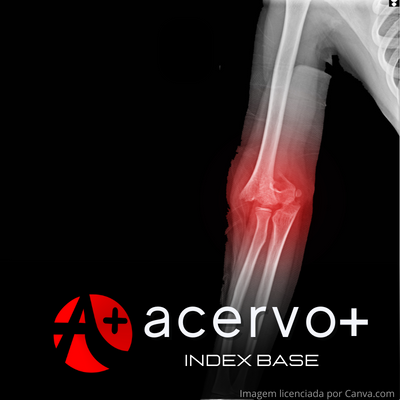O úmero distal e suas vertentes do tratamento de fraturas em adultos
##plugins.themes.bootstrap3.article.main##
Resumo
Objetivo: Fraturas de úmero distal ocorrem de 2 a 6% das fraturas em geral e em até 30% das fraturas de cotovelo em adultos, com alto potencial de complicações devido à comprometimento neurovascular e rigidez articular, somado à dificuldade técnica de abordagem e fixação com placas. A fim de revisar as formas de manejo e conduta em fraturas articulares de úmero distal, e analisar então as vantagens e desvantagens de diferentes técnicas de redução aberta e fixação. Revisão bibliográfica: Foram identificadas formas de abordagem aberta e redução fixação de tais fraturas, ao qual os autores discorrem sobre abordagem para tricipital e trans olecraniana, em que a redução fixação varia entre a fixação com placas em posição ortogonal e paralela. A comparação de eficácia variou desde estudos biomecânicos com modelos artificiais até estudos clínicos, com variedade de resultados a curto e longo prazo. Considerações finais: Há evidências de que a abordagem trans olecraniana proporciona melhor exposição, apesar de maiores complicações a curto prazo, somado a melhor eficácia biomecânica de placas em posição paralela, contudo a experiência profissional é um fator diferencial e importante quando se planeja tal abordagem.
##plugins.themes.bootstrap3.article.details##
Copyright © | Todos os direitos reservados.
A revista detém os direitos autorais exclusivos de publicação deste artigo nos termos da lei 9610/98.
Reprodução parcial
É livre o uso de partes do texto, figuras e questionário do artigo, sendo obrigatória a citação dos autores e revista.
Reprodução total
É expressamente proibida, devendo ser autorizada pela revista.
Referências
2. ATALAR AC, et al. Biomechanical comparison of orthogonal versus parallel double plating systems in intra articular distal humerus fractures. Acta Orthop Traumatol Turc., 2017; 51(1): 23-28.
3. BAYDAR M, et al. Isolated capitellar fractres fixation with headless screws in different configurations. Acta Ortopédica Brasileira, 2022; 30(1).
4. CHEN H, et al. Comparison of treatments in patients with distal humerus intercondylar fracture: a systematic review and meta-analysis. Annals of Medicine; 2017; 49(7): 613-625.
5. GOSLER MW, et al. Surgical versus non- surgical interventions for treating humeral shaft fractures in adults. Cochrane Database of Systematic Reviews, 2012; 1: CD008832.
6. GIOSTRI GS. Manual de trauma ortopédico. Sociedade Brasileira de Ortopedia e Traumatologia. 2011; 1(1): 102-114.
7. JACKSON N, WATERS E. Criteria for the systematic review of health promotion and public health interventions. Health Promot Int., 2005; 20(4): 367-374.
8. JEONG HS, et al. Comparison of olecranon osteotomy and paratricipital approach in distal humerus intra-articular fracture: A systematic review and meta-analysis. Baltimore, 2022; 101(34): 302-316.
9. JUNG SW, et al. Triangular fixation technique for bicolumn restoration in treatment of distal humerus intercondylar fracture. Clin Orthop Surg., 2016; 8(1): 9-18.
10. KONG L, et al. Biomechanical properties of a novel fixation system for intra-articular distal humerus fractures: a finite element analysis. Journal of Orthopaedic Surgery and Research; 2021; 16: 674.
11. KURAL C, et al. Bicolumnar 90-90 plating of AO 13C type fractures. Acta Orthop Traumatol Turc., 2017; 51(2): 128-132.
12. LU S, et al. Olecranon osteotomy vs. triceps-sparing for open reduction and internal fixation in treatment of distal humerus intercondylar fracture: a systematic review and meta-analysis. Chin Med J., 2021; 134(4): 390-397.
13. FILHO GM, GALVÃO, MV. Rigidez pós-traumática do cotovelo. Revista Brasileira de Ortopedia, 2010; 45(4): 347-354.
14. HERBERT SK, et al. Ortopedia e traumatologia: princípios e práticas. Porto Alegre: Artmed, 2017; 1(5): 2245p.
15. NUNES MC, et al. Biomechanical analysis of two types of humerus supracondylar fracture fixation in anatomical model. Revista Brasileira de Ortopedia, 2016; 54(3): 261-267.
16. SCHMIDT-HORLOHÉ KH, et al. Promising results after the treatment of simple and complex distal humerus type C fractures by angular-stable double-plate osteosynthesis. Orthop Traumatol Surg Res., 2013; 99(5): 531-41.
17. SHIH CA, et al. Parallel versus orthogonal plate osteosynthesis of adult distal humerus fractures: a meta-analysis of biomechanical studies. Int Orthop., 2019; 43(2): 449-460.
18. STEVENS NM. Distal Humerus Fractures Evolution of Management. J Orthop Surg Res., 2021; 79(1): 43-50.
19. TAK SR, et al. Outcome of olecranon osteotomy in the trans-olecranon approach of intra-articular fractures of the distal humerus. Ulus Travma Acil Cerrahi Derg., 2009; 15(6): 565-70.
20. THE OTTAWA HOSPITAL RESEARCH INSTITUTE. The Newcastle-Ottawa Scale (NOS) for assessing the quality of nonrandomized studies in meta-analyses. 2018.
21. WANG Y, et al. Surgical interventions for treating distal humeral fractures in adults. Cochrane Database of Systematic Reviews. 2013; 1; CD009890.
22. WEI L, et al. Biomechanical analysis of a novel plating for intra-articular distal humerus fractures: combined anteromedial and anterolateral plating. Journal of Orthopaedic Surgery and Research; 2019; 14: 132.
23. WEI LB, et al. Surgical treatment of intra-articular distal humeral fractures by using a combined medial and lateral approach: an anatomic study. Orthop Surg., 2019; 11(3): 524-529.
24. WU ZZ, et al. Surgical exposures of the distal humeral fractures: An anatomical study of the anterior, posterior, medial and lateral approaches. Chin J Traumatol., 2018; 21(6): 356-359.
25. YETTER TR, et al. Complications of articular distal humeral fracture fixation: a systematic review and meta-analysis. Journal of Shoulder and Elbow Surgery; 2021; 30(8): 1957-1967.

